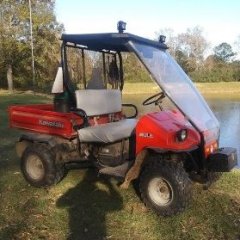-
Posts
2,801 -
Joined
-
Last visited
-
Days Won
191
Content Type
Profiles
Events
Forums
Gallery
Downloads
Community Map
Everything posted by Travis
-
Nahhh, we only get 97.9% humidity here in southeast Texas, so it's a walk in the park compared to Lou'sana humidity.
-
i would pull the valve cover and check the valve clearance .. if there is a flat cam lobe, the valve clearance will be excess... unless this uses a Over head cam engine.
-
-
AND I WOULD LIKE TO INFORM YOU ALL, I STILL HAVE 10 DIGITS.... as far as i know.
-
Photo's from tonight.. i was sweating like a pig afterwards 😛 The Rockets Red Glare The Bombs bursting in air
-

2020 outfitter 550, Power to dash, but not starting
Travis replied to Dabadoo's topic in Coleman UTV SxS Forum
Could be starter or starter solenoid. -
In Lou'sana,,, i bet it's the humidity.... but just think, if you go all electric you can be like a tesla owner and carry a Honda generator in your bed. Or my electrical gremlins hopped over to your machines.
-

my hisun e wont start it just beeps when iturn it on
Travis replied to david barry's topic in Hisun UTV SxS Forum
I'd check your engine oil level, in case it has a oil sensor -
believe me it is
-
does the engine use a magneto/flywheel ignition system like a mower engine.... or does it cut off fuel like a diesel?
-

Kawasaki Mule 550 Charging Coil replacement
Travis replied to Travis's topic in Kawasaki UTV SxS Forum
Part 4 -
maybe we should just tell them the next full moon is the harvest moon so it will happen quicker............
-

Kawasaki Mule 550 Charging Coil replacement
Travis replied to Travis's topic in Kawasaki UTV SxS Forum
PART 1 PART 2: MORE VIDEOS TOMORROW... DON'T EAT ALL YOUR POPCORN. -

Kawasaki Mule 550 Charging Coil replacement
Travis replied to Travis's topic in Kawasaki UTV SxS Forum
Tools you'll need Socket Set (8mm for ignition coil, 10mm for fan shroud, 12 MM to remove control panel cover to access a fan shroud bolt, 12mm, long extension and U-Joint adapter to remove starter, 12MM to remove exhaust pipe nuts from head, 10mm open end to remove nut and bolts for exhaust pipe mount, ,7/8 or 22MM socket to remove flywheel nut, Large Large phillips head screwdriver for stator screws Three Jaw Puller electric,battery or air impact wrench to remove flywheel nut Business card or .012" feeler gauge to reset ignition coil air gap a can of Liquid Wrench.... if you're flywheel nut has been on awhile i advise you spray it with liquid wrench or your favorite penetrating fluid a for several days in a row prior to work. 7. 2 or 3 pound hammer. (large hammer) Let's get started....... First, remove the fan shroud screws (10mm), there are 6 in total... 2 on the bottom corners, one by the oil filter, 2 on top, and on on the backside facing the trans/rear end... you will need to remove the throttle control cover, with a 12mm and you may need to drill out the tamper preventive rivet, to access a screw. now that they're loose, take a 12mm and loosen the exhaust pipe nuts on the head and remove the lockwashers, next use a 10mm socket and open end wrench to remove the tailpipe flange joint at the muffler flange joint, and the support bracket. you have to wiggle and wiggle it around to remove the exhaust pipe, there is no good way to do it... now remove the fan shroud, you have to wiggle and wiggle it as well. as this point i would remove the starter, with a 12mm, and for the bottom bolt a 12mm on a long extension with a Ujoint adapter. next remove the ignition coil, two 8mm screws are holding it on, don't forget to remove the kill wire. Now use a 7/8 or 22mm socket to remove the flywheel nut. a large impact wrench comes in handy here. if you don't have an impact, remove the spark plug and rotate the engine to where the piston is at the bottom of the bore, and insert some clean rope or cord into the bore, now loosen the flywheel nut... the rope will act as a piston stop compressing it against the cylinder head. Now i''d recommend removing the cooling fan with a 10mm socket. 3 screws hold it on. easy. now if the flywheel didn't pop off the taper on its own, time to get the 3 jaw puller, it is critical that the jaws be fully seated around the flywheel as not to damage the ring gear teeth. that is why i recommend removing the coil and starter. i usually thread the nut back on the shaft flush with the top of the threads to prevent any deformation of the threads., now fit the puller. use a adjustable or 15/16 wrench to tighten the puller ram. as soon as it gets tight, use a large hammer and pop the hex end of the puller a few times, tighten the puller again and give it a few good whacks. don't be afraid. keep doing that until the flywheel pops off. take note of where the key is... it shouldn't fall off the crankshaft so don't worry too much about losing it. now that the flywheel is off you can see the stator. 4 phillips head (technically JIS i think) are holding it on.. they aren't terribly tight. just snug. i put the screwdriver into the head, and use a hammer to hit the end of the driver a time or two to make sure the driver is fully seated to prevent the heads from stripping. now that the 4 screws are removed, take off the old stator, and unplug it from the harness. there is a small clamp towards the top of the engine block that keep the wires out of the flywheel, bend it back to pull the wires out. the stator should just pull right off.. I'd clean up the stator screws with parts cleaner and compressed air, as well as blow out all the trail dust from off of the flywheel and on the engine block. inspect the oil pump cover and shaft seal for leaks. also blow out the cylinder cooling fans to clear out any dust. it will cool better. now get your new stator, (59031-2097) it kind of fits on to the casting of the block, and reinstall the 4 screws. there is no published torque spec for these screws, so i did as much as could with my hand driver, and then used a wrench on the hex portion of the screw driver and went about3/16 of a turn more. make sure the stator wires fit in the groove of the casting and secure them behind the clip/guard. align the flywheel keyway and the flywheel key on the crankshaft and install the flywheel. feel free to clean up the shaft with some sandpaper if needed, DO NOT put any sort of lubricant on the shaft taper, you can very well crack the flywheel when you go to tighten it. reinstall the washer and nut, torque to 64 ft/lbs. or if you have a 1/2" impact thats about 4 "tat tat tat tat's" reinstall the cooling fan, only goes on one way. reinstall the starter and ignition coil, gap the coil to .012" or a business card will work fine... there is very little room to work with your hands gapping the ignition coil, as you'll see in the video.. don't forget to reinstall the kill wire. now reinstall the fan shroud, and exhaust pipe.. plug in the stator wires, back to the harness, doesn't matter which one. after making sure all connections and necessary hardware is tight, FIRE IT UP! set your meter to DC voltage, battery should read anywhere from 12.5 to 12.7 at idle, and go up to about 14.5 volts at WOT., but not exceed 15 volts. should hang right around13.5 at mid range RPM. NOW WHAT I DID different: i put in new stator wires . i nullified the stator wires in the harness. they're just there now.... i purchased Name Brand bullet connectors, heat shrink and solder. and 14 gauge (I Believe the OEM are 16 gauge) Copper wire. (southwire on amazon) and some 3/8 PVC wire loom. cut the 2 wires to 4ft in length, on one end i put the female bullet connectors, and the other spade connectors for the regulator. now awhile back i put a pigtail on my regulator since didn't like how tight the wires were and pulling... the A/C input on the regulator are the on the back left and back right spots on the regulator... what i did was crimped the spade connectors on the wire, soldered the wire to the connector, and then when i plugged the two wires together, i soldered them together as well as heat shrinked them. all connections stayed cool while running. which is good. 6/28/21 VIDEOS TO COME.......... -

Kawasaki Mule 550 Charging Coil replacement
Travis replied to Travis's topic in Kawasaki UTV SxS Forum
The Stator has been replaced and it's a charging son of a gun... I've got several parts with a How To video coming soon and a good write up... Due to my inept filming skills there are several parts to it...... -
The J word got Cancel Cultured so it doesn't apply 😝😝
-
31 days with no issues with the John Deere starter assist relay... 36 days is the goal to beat.
-
i don't know much about the CC UTV's, but 1 thing i can think of is 1. If it has seat belts, and they aren't buckled, it could be limiting the speed.
-
I'd find which wire powers it, and cut it... leave enough slack to where it could spliced at later date if needed.
-
Is it a Briggs & Stratton?
-
I'd unplug the sensor and see what happens.
-
-
Welcome! If it were me i'd try some Blue Loctit on the nut, could be a cheap fix. Or take the nut to a hardware store and get Nylock nut







